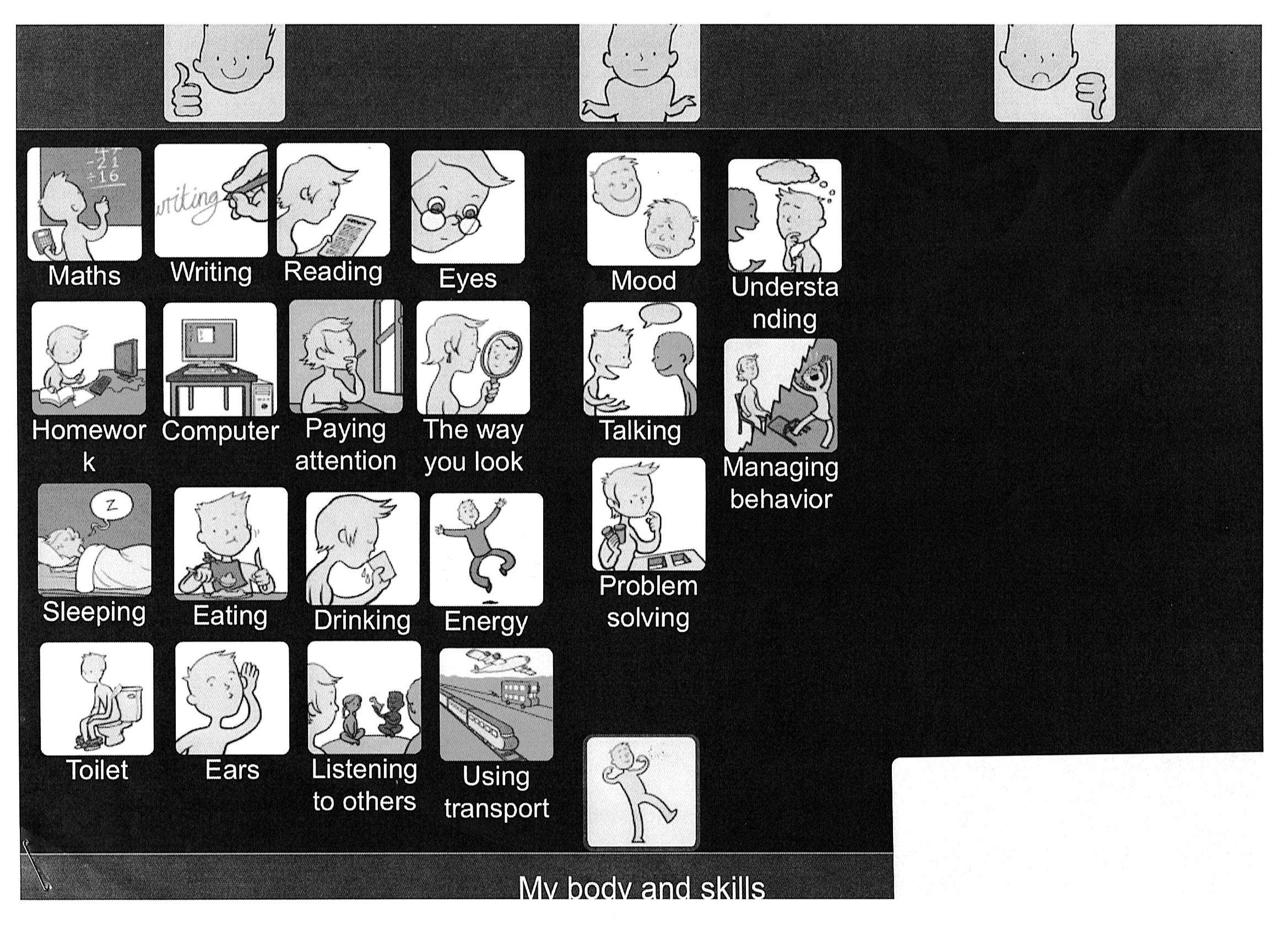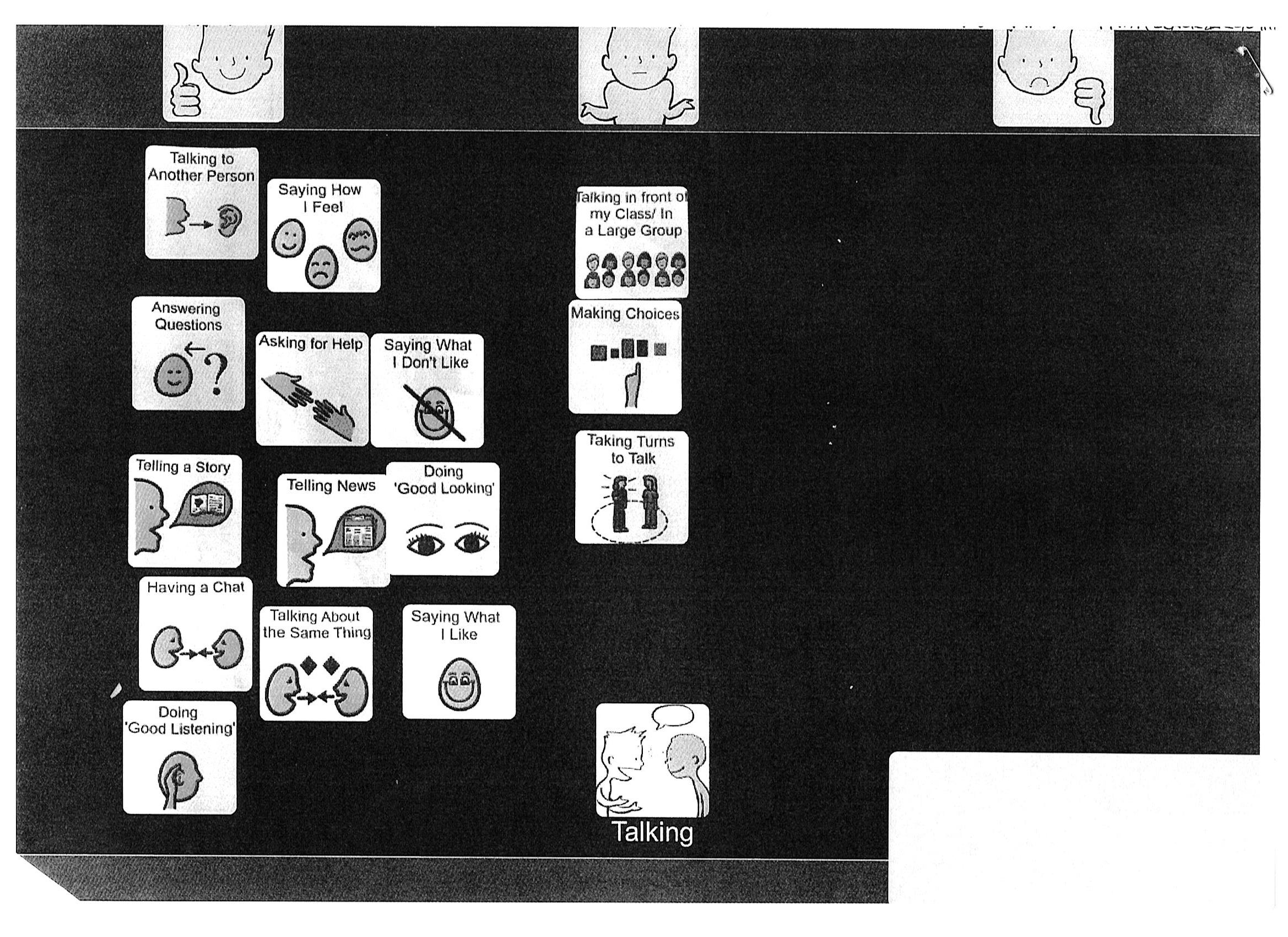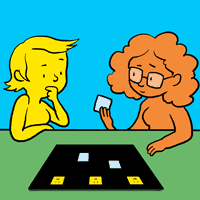Thanks to Laura Holmes for telling us more about the innovative work in Stockport.
As part of an ongoing project, we at NHS Stockport Children’s Speech and Language Therapy Service are introducing the Talking Mats approach to support the children we work with to contribute to their own EHC Planning, enabling them to make their voices heard.
For example, I have used the ‘Consulting Children and Young People – My Body and Skills’ (Primary) digital resource to help identify and plan target areas for an 6 year old child with a diagnosis of Autism. I selected a top scale of ‘happy/unsure/not happy’ and chose a variety of options symbols from the resource. The child (R) was then able to drag and drop each option symbol to the area she felt it belonged in, producing the following talking mat:
Whilst completing the mat the child volunteered further information about particular options – in general I find I get to know the children I work with much quicker using this approach!
Once complete, we agreed that we would sub-mat the option ‘talking’ (which had been placed under ‘unsure’) and explore that option as a topic in our next therapy session.
I then thought about all the possible options I wanted to explore in this submat, and created symbols using Boardmaker. I was able to add these symbols as options for the digital mat by taking photos using my Ipad and selecting them from my camera roll.
R completed the submat as follows:
The mat enabled R to pinpoint the areas of talking she feels unsure about – i.e. ‘talking in front of my class/ in a large group’; ‘making choices’; ‘taking turns to talk’. I was then able to include this information in my review report, attaching the pictures of the mats as evidence of consultation. My review report included details of specific targets and recommendations to support R to work on the areas she had identified, which are designed to be incorporated into her EHC Plan.
We know from our own network that many practitioners are looking for training and tools to help implement the SEND reforms. Talking Mats are running a free seminar in Stockport to let practitioners see how Talking Mats can be used. The morning session is FULL but we have added an afternoon session. Book your place now as it is first come first served and places are filling up fast. Free Stockport afternoon seminar
Talking Mats considers both health and social aspects when it is used to include people in their care planning. Lots of interesting comments are made by course participants on the forum in our online training course. Annemarie, who works as an agency carer visiting clients in their own homes posted her thoughts about the social model of disability
Remembering the person behind the condition
In my experience, society is fixated on the medical model, the ‘what’s wrong’ approach. Whilst the medical model is clearly a valuable and required tool, it often leads to labels that individuals are then lumbered with, such as, ‘she has dementia’, ‘she is visually impaired’, ‘he’s deaf’ or has a ‘leaning disability’. Taking this approach overlooks the person behind the ‘condition’ and so can restrict inclusion. One example could be an individual with dementia being unable to make everyday choices about seemingly mundane issues such as what to wear that day. Using a medical model, a carer may be aware of the clients difficulties and make choices for them, whereas using the social model approach enables the carer to see beyond the condition and fully include the client, allowing them to be part of the decision making process for themselves. A second example could be a person with a communication disorder such as Asperger’s Syndrome. Access to work could be severely restricted using a medical model as the pragmatic manifestation of this condition may well exclude a person from seeking certain types of employment. Promoting the use of a social model would ensure work colleagues understood the possible limitations of the condition and ensure adequate support networks were in place. The social model attempts to embrace a person’s difference and raises awareness within society of individual needs that will facilitate inclusion into all aspects of life.
The WHO ICF -World Health Organisation International Classification Framework of Functioning, Disability and Health (2001, 2007b) aims to merge the medical and social model, encouraging professionals to think not only of the persons health condition and resulting impairment, but the impact this has on the persons participation and activities. It captures the full complexity of people’s lives, including environmental and social factors and can be applied over different cultures
The Talking Mats Health and Well- being resource is based on the WHO ICF and supports a person to reflect and express their view on various aspects of their lives. Using the Health and Well being resource supports workers to remember the person behind the condition.
Thanks to Laura Holmes for telling us about the innovative work in Stockport.
The new SEND reforms in England, as described in the SEND Code of Practice: 0-25 years (2014), have highlighted the need for health, education and social care professionals to involve children and young people in decision-making processes, in particular, during the assessment, production and review of Education, Health and Care (EHC) Plans.
In NHS Stockport Speech and Language Therapy Special Needs Service, we have recognised this need and are in the process of introducing the Talking Mats approach to enable the children we work with to share their views and opinions – i.e. to hear the ‘Voice of the Child’. We also obtain the views of parents/carers and school staff through use of questionnaires. These views and opinions are then incorporated into a child’s Individual Therapy Plan and consequently their EHC Plan.
Children with Speech, Language and Communication Needs (SLCN) can often struggle to express their views and opinions. We have found that Talking Mats is a highly effective way of gaining the views of the children and young people we work with, whether they are verbal or non-verbal. Talking Mats enables them to become involved in their own therapy planning and interventions, which in turn feeds into the EHCP process.
In addition, the Talking Mats approach links well with the use of Therapy Outcome Measures (TOMS), particularly in relation to the evaluation of the general activity, participation and well-being of a child/young person. TOMS is the outcome measurement tool recommended by the Royal College of Speech and Language Therapists (RCSLT).
In my next blog, I will provide an example of how Talking Mats has helped the children we work with to participate in the EHC plan process.
We know from our own network that many practitioners are looking for training and tools to help implement the SEND reforms. Talking Mats are running a free seminar in Stockport to let practitioners see how Talking Mats can be used. Book your place now as it is first come first served. Free seminar Stockport
 Online training login
Online training login 






